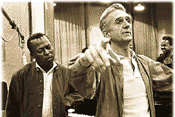Between funk and ruin
 When in May 1980 Miles recorded The man with the horn (Columbia, 1981) he had passed five years without picking up the trumpet. Earlier, Agharta and Pangaea had appeared, but both were "only" recordings captured during the Festival in Osaka, 1975, the year in which he suffered pneumonia, the year he suffered hip surgery, the year his friend Cannonball died at 46... Miles lived cloistered at home, enduring a long hangover from the years of madness in which, as he tells in his autobiography, "sex and drugs had taken the place that music had in my life until I reached a point where I spent all the hours of the day in those two things". His friends feared the worst. Columbia and United Artists fought to hire him. Miles accounts were in the red. But he kept getting high. And did not play.
When in May 1980 Miles recorded The man with the horn (Columbia, 1981) he had passed five years without picking up the trumpet. Earlier, Agharta and Pangaea had appeared, but both were "only" recordings captured during the Festival in Osaka, 1975, the year in which he suffered pneumonia, the year he suffered hip surgery, the year his friend Cannonball died at 46... Miles lived cloistered at home, enduring a long hangover from the years of madness in which, as he tells in his autobiography, "sex and drugs had taken the place that music had in my life until I reached a point where I spent all the hours of the day in those two things". His friends feared the worst. Columbia and United Artists fought to hire him. Miles accounts were in the red. But he kept getting high. And did not play.Actress Cicely Tyson, who had been his lover and friend, saved his life, in the words of Miles, and helped him to focus his interest in health and music. She was not the only one who helped him. Many musicians used to come to Miles' home to visit and cheer. Chaka Khan, who was his neighbor forced him to be cleaned. But it was the drummer Vince Wilburn, nephew of Miles, who took him out of that state of suicidal depression. His uncle had given him a drum battery when he was seven, and now he was in a group of Chicago that played a mixture of jazz, soul and funky. Miles listened to the demos and take them to Columbia. The result was that the other group members met with Vince Wilburn and Miles in New York to record some tracks. Miles was ready to return.
After a month of rehearsals, Miles wanted to tape thtat music. He asked Dave Liebman to find him a saxophone and he recommended a former student of his, Bill Evans. "If I played the sax, I would do it like you" said Miles after listening to Bill playing, and Evans became part of the history of Miles.
In previous years, there were many jazz musicians who died young, some of them were friends of Miles, so Gerry Mulligan, called him to celebrate his return to the world of the living. He had heard that he was recording again. Mulligan said, "I hope you play beautiful things for us, the guys who love you", to which Miles replied: "No, guy ... I'll make a funky band to make money." The result was a theme that shines, "The Man With The Horn", which would give title to the trumpeter's comeback album. It is said that Miles had not yet regained the art, and that his trumpet tracks were added later, but this could well be part of the legend. It had passed many years since his fans last heard Miles playing in his true style.
In a later session, Miles would replace the group of his nephew by people like Marcus Miller on bass, Sammy Figueroa on percussion, Mike Stern on guitar, Al Foster on drums, but did not get complete the album until much later, in a recording session in May 1981, in which Vince Wilburn and his group met again with Miles in New York to record the song "Shout" with a boldly disco sound.
The result album blends jazz-rock tracks and soul-funk with the indelible mark of the thick experiments in which Miles had messed in the previous decade. However, it was a hit on radio stations, especially through the title track to the album.
___________ ___________
* Photo by Rico D'Rozario ( www.ricodrozario.com ): Al Foster, Miles Davis and Mike Stern in 1982. 











No comments:
Post a Comment